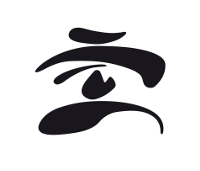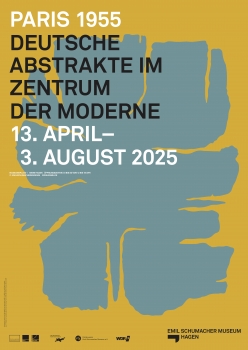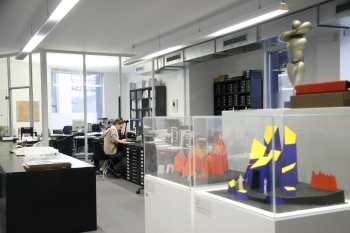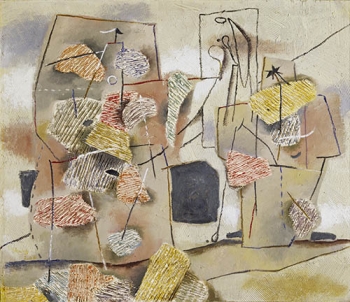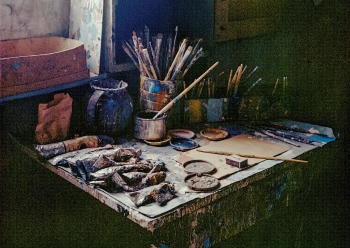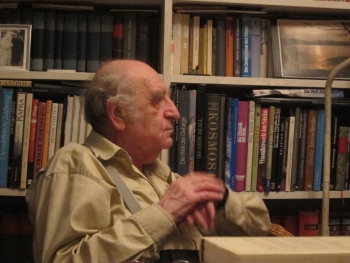Until then, only a few German artists had succeeded in establishing contacts with galleries and critics in neighboring France after the end of the Second World War. Presenting works in groups and solo exhibitions in Paris, the world capital of art at the time, enabled up-and-coming artists such as Brigitte Meier-Denninghoff, Emil Schumacher and Karl Otto Götz, as well as established colleagues such as Willi Baumeister, Ernst Wilhelm Nay and Fritz Winter, to achieve nothing less than an international breakthrough.
The exhibition at the Cercle Volney presented the varieties of abstract art that were represented in West Germany in the mid-1950s. The reconstruction thus creates a multifaceted picture of post-war abstract art, which includes rediscoveries of artists alongside the familiar ones. In retrospect, however, the special feature of the exhibition is not only that art from Germany was shown. Much more significant is the fact that the younger participants are now regarded as the main representatives of Art Informel.
In addition to Götz and Schumacher, they include the painters Fred Thieler and K. R. H. Sonderborg or Brigitte Meier-Denninghoff and Norbert Kricke from the field of sculpture. From today's perspective, their names are an integral part of post-war German art history.
In 1955, their artistic expression was still revolutionary. However, the fact that informal art was still new in Germany in the 1950s and was not unreservedly recognized is demonstrated by the tense history of the Paris exhibition. For example, Wessels and Drouin's anti-hierarchical exhibition concept was massively thwarted by official bodies in Germany.
The exhibition was finally opened on April 7, 1955 against all resistance and was enthusiastically received by the French and German press. Critics were amazed at the international standard, diversity and expressiveness of the artists from Germany. Drouin and Wessel's contribution to Franco-German cultural transfer can therefore hardly be underestimated. They succeeded in organizing an exhibition in Paris that would hardly have been possible in Germany at that time.
For the Hagen exhibition, which was conceived in cooperation with the Informal Art Research Centre at the Institute of Art History at the University of Bonn, by Dr. Anne-Kathrin Hinz as guest curator together with Rouven Lotz, Director of the Emil Schumacher Museum, the roles of the institutions and individuals involved are placed in their historical context. In particular, the anti-hierarchical exhibition concept of Drouin and Wessel in the Cercle Volney is the focus here.
The exhibition will be shown over a period of around four months from 13 April to 3 August 2025 and will be accompanied by a catalog with texts by Anne-Kathrin Hinz, Rouven Lotz and Christoph Zuschlag - hardcover, Deutscher Kunstverlag, ISBN 978-3-422-80342-8, € 30 (in the museum) / € 35 (in bookshops) - as well as an extensive supporting program.
Illustration after a serigraph of the motif ARU 7, 1955, by Willi Baumeister. White poster paper, 61.2 x 43 cm, edition unknown. The lettering was not set by the artist. Printed by Poldi Domberger, Stuttgart. VG Bild-Kunst, Bonn 2025
https://www.esmh.de/web/de/esmh/index.html
Once a quarter, we offer backstage tours of the Baumeister archive. Original letters, sketches, photos, etc. from the artist's estate are on display.
Date: 25 July 2025 6 pm, 60 minutes
Meeting point in the foyer of the Kunstmuseum Stuttgart: limited number of participants
Information and registration: fuehrung@kunstmuseum-stuttgart.de or T: +49 (0) 711 / 216 196 25
Participation fee € 3 / reduced € 2 (plus admission to the collection)
THE ART IS IN THE MEANS
Willi Baumeister; Adolf Hölzel and their materials
March 10, 2024 - September 29, 2024 I Adolf Hölzel Foundation
Accompanying the exhibition, the artist Valentino Berndt (*1988) shows works in the basement of the Hölzel House. Duration of the exhibition: 10 March - 28 April 2024.
Opening of the exhibition on Sunday, 10 March 2024 at 11 am. The director of the Baumeister Archive at the Kunstmuseum Stuttgart Hadwig Goez and the director of the Hölzel-Haus Isabell Ohst will speak.
Followed by a performance by Valentino Berndt on his work Generalbass.
Guided tour through the Baumeister Archive at the Kunstmuseum Stuttgart
We visit the Baumeister Archive at the Kunstmuseum Stuttgart and get an exclusive look behind the scenes of the archive work and the works of Willi Baumeister. The visit ends in the permanent exhibition of the Kunstmuseum Stuttgart.
Friday, 19.04.2024, 18:00 hrs
Friday, 13.09.2024, 18:00 h
Costs: Admission to the art museum
Registration and further information at https://www.adolf-hoelzel.de/
INNOVATION OR REPLACEMENT? Art technological research on new painting materials between 1930 and 1955 using the example of Willi Baumeister (duration 2022-2027)
These questions of art technology and conservation science will be investigated using the extensive holdings of paintings and archival materials of the cooperation partners - the Baumeister Archive at the Kunstmuseum Stuttgart (Hadwig Goez) and the Willi Baumeister Foundation as well as the Staatsgalerie Stuttgart.
The Schoof'sche Stiftung is supporting the project by covering the costs of extensive material analyses, which are being carried out in cooperation with the Technical University of Cologne, the Deutsches Museum Munich and the Doerner Institut of the Bavarian State Painting Collections (Munich), the InsiTUM Lab of the Technical University of Munich under the direction of Dr. Clarimma Sessa (Chair of Prof. Dr. Thomas Danzl) and Prof. Dr. Óscar Andrey Herrera Sancho (Humboldt Fellow, 5th Institute of Physics, University of Stuttgart).
Another central concern of the project is to communicate both the research process and the results to different target groups. To this end, project-accompanying communication formats and an exhibition at the Kunstmuseum Stuttgart (planned for 2027) will be developed, which will be financially supported by the Wüstenrot Foundation. The project will also conclude with an international symposium at the ABK Stuttgart, which will take place alongside the exhibition.
Project management:
Prof. Dr. Wibke Neugebauer https://www.abk-stuttgart.de/personen/wibke-neugebauer.html
Hadwig Goez https://www.kunstmuseum-stuttgart.de/archiv-baumeister
ABK Stuttgart https://www.abk-stuttgart.de/gemaelde-und-skulpturenrestaurierung
Photo by Fritz Seitz: © Esther Hagenlocher, Fritz Seitz, "Alte Apotheke" Nusse, near Lübeck 2014.
Fritz Seitz's scholarly work is currently being reappraised. His 36 "Thema Farbe" pamphlets, published from 1962 to 1984, comprise the art educator's combination of color theory with innovative examples of applied art.
Esther Hagenlocher, an Associate Professor at the University of Oregon, is leading the collaborative effort with the Willi Baumeister Foundation and the Baumeister Archive at the Kunstmuseum Stuttgart to develop the first scholarly indexing in German and English. This research will enhance the accessibility and understanding of Fritz Seitz's works in the field.
Fritz Seitz on his teacher Willi Baumeister: "A Guarantee for something entirely different"
Discover the unique perspective of Fritz Seitz's approach to Color and its impact.
Click HERE to delve deeper into this subject.
Link to University of Oregon
